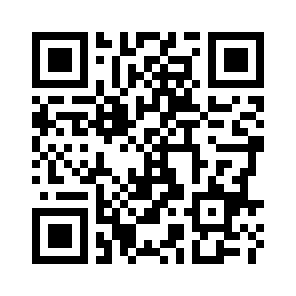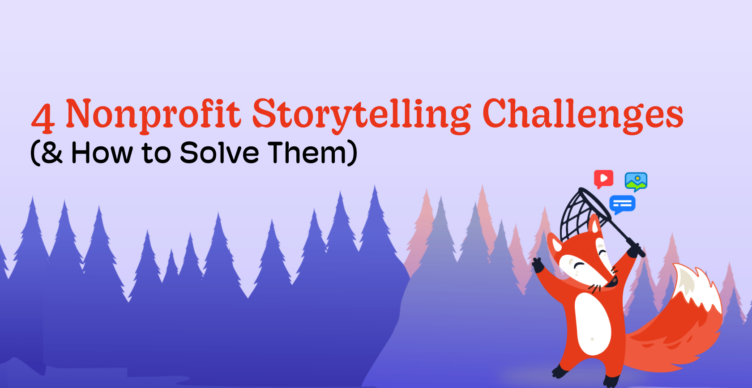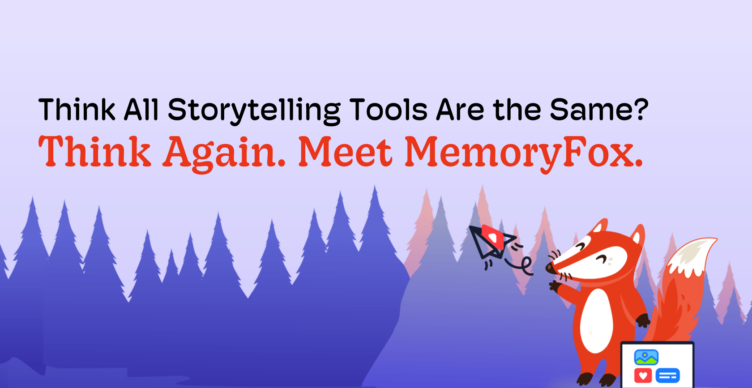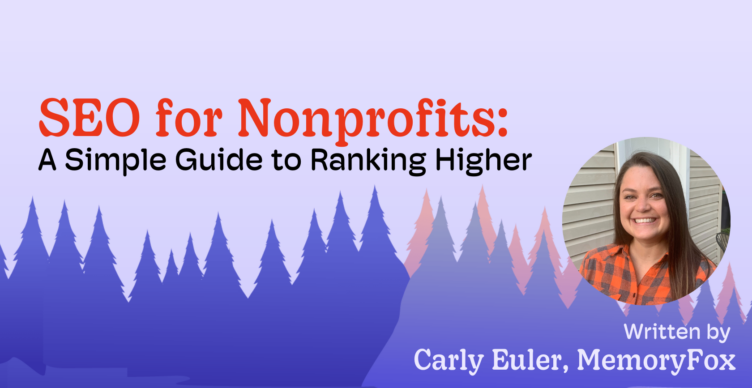Fundraising Tips, Social Media Ideas
Amplify Peer-to-Peer Fundraising with a Social Media Toolkit
Happy March! Spring and summer are rapidly approaching, which means your nonprofit is gearing up for its outdoor fundraising events and activities. Events like:
-
- 5k, 10k, Half Marathon or Marathon Races
- Walk-a-thons or Family Fitness Walks
- Fitness Challenges (Example: Complete X amount of miles in X amount of days)
Most of these types of events involve peer-to-peer fundraising (P2P). Peer-to-peer fundraising is a wildly successful way to increase brand awareness, and, of course, raise more funds. It also happens to be my favorite type of fundraising! Find out why by listening to our latest Storytelling With A Purpose episode.
P2P is such an important part of nonprofit fundraising, that MemoryFox has decided to dedicate the entire month of March to this theme.
 But first, what is a peer-to-peer fundraiser?
But first, what is a peer-to-peer fundraiser?
According to our friends at GiveButter, “A peer-to-peer fundraiser is a fundraising campaign where a group of loyal supporters recruit their own network to support their cause.”
In other words, a peer-to-peer fundraiser is a campaign in which funds are raised when an organization’s supporters (the first “P” in P2P) ask their personal connections- mainly, friends and family (the second “P” in P2P) – to donate to a nonprofit. Most of the time, P2P campaigns are run in conjunction of an event (in-person or virtual) hosted by the nonprofit.
Overall, the pillar of peer-to-peer fundraising is trust. We ask our friends and family members their opinions on so many things in our lives: relationship advice, career trajectory, car purchases, fixer upper projects, cleaning remedies… Everyone has opinions based on their lived experience and shared knowledge.
A peer-to-peer campaign is exactly the same. YOU are recommending a nonprofit organization to your friends and family based on the experience and knowledge you have. They are willing to donate because they trust YOU and therefore trust your endorsement.
So do the peer-to-peer fundraisers do all the work?
Well, not exactly! The key to running a successful peer-to-peer campaign is to empower your fundraisers by making it as easy as possible for them to raise funds. Often, it is not in someone’s nature to ask others for money. As a nonprofit fundraising professional, that’s where you come in!
Creating and distributing a social media toolkit is the best way to empower your supporters to reach their fundraising potential. Here are the benefits of providing a well thought-out social media toolkit to your P2P fundraisers:
-
- Consistency: A social media toolkit helps ensure that all messaging and branding is consistent across all fundraising efforts. This consistency can help to build trust and credibility with donors, it enhances brand awareness as you reach a new audience, and acts as a secondary advertisement for the event you are promoting.
-
- Easy sharing: Providing prewritten social media posts, images, and videos makes it as easy as possible for supporters to share correct information about your nonprofit’s mission, values and the specific event this fundraiser is supporting.
-
- Increased reach & engagement: With more people sharing your content, the organization can reach a broader audience that may not have been aware of their mission or cause. When a supporter shares content, their friends and family are more likely to feel connected to your cause because of the personal endorsement.
-
- Saves time & resources: A social media toolkit saves time and resources by providing fundraisers with an easy-to-use kit that they can share without requiring the nonprofit staff to create custom content for each individual supporter. A toolkit also provides the fundraiser with the power and confidence to share their fundraiser when and where it works best for them.
But, how do you get started?
Don’t fret! I have an example social media toolkit for you to view and recreate. This is a real toolkit that I created when I was the Director of Special Events for the Breast Cancer Coalition.
It includes examples of graphics, captions, helpful hints & tricks for the 2022 Pink Ribbon Walk & Run. For this campaign, we had over 100 individual fundraisers and raised more than $100,000 in just 4 months. It was incredible to see our organization tagged in these graphics and captions across all channels.
It’s all yours to emulate, just “Make a Copy” of this document by clicking “File” and then “Make a Copy”. Get it now:
Now that you have your example, let’s take it one step further!
Here are your 5 ways to amplify peer-to-peer fundraising with a social media toolkit:
-
-
Encourage personalization, but always provide a universal template.
-
Storytelling is the single most powerful way to connect a person to your mission and inspire them to give. (We know this. It’s sort-of our whole “thing” here at MemoryFox). The same premise goes for peer-to-peer fundraising.
Peer-to-peer fundraising is MOST successful when individuals share their own story and connection to the mission on their fundraising pages.
 It is essential that your toolkit provides places and reminders for them to insert their personal messaging.
It is essential that your toolkit provides places and reminders for them to insert their personal messaging.
But, whether they realize it or not, you will always get people who will create and share their unique fundraising pages without updating the story or profile picture portions. That is why you need to set them up for success by providing a universal template that sounds as genuine as possible (without identifying factors) as well as a default branded profile photo.
Don’t let your fundraisers get caught with brackets that say [add your name here] on their unique fundraising pages. Pretend you are in their shoes by using “I” statements as much as possible.
-
-
List VERY specific instructions.
-
While you might spend hours a day on social media, that doesn’t mean your fundraisers do. So, when it comes to social media knowledge, my advice to you is to assume they know nothing! When you start at a “nothing” baseline, you curb the potential for confusion and frustration from those who are trying their best to raise money for you.
Provide every single step-by-step instruction you can think of that will assist your supporters.
A great example of this involves Instagram and hyperlinking in captions. When you put a website link in an Instagram caption, it does not become clickable. This means that in order for someone to donate to that page, they MUST copy and paste the link or type the link into their browser. That is asking too much of people who are just scrolling through their social channels in their down time.
Instead, remind your fundraisers who use Instagram to add their unique fundraising page as the link in their bio.
-
-
Give helpful hints & send reminders.
-
In addition to instructions, make sure your social media toolkit is FULL of helpful hints that will excite your supporters, spark creativity and boost engagement. A few examples of helpful hints to include are:
-
- Thank your donors in the comments section.
- Record a video sharing your story.
- Use your personal photos.
Then, take it one step further by sending a weekly reminder to your fundraisers! Each reminder should include one helpful hint and provide fundraising updates. This will keep the momentum going and provide a healthy dose of competition to your supporters.
-
-
Create several graphics to choose from.
-
Your fundraisers want options! I recommend providing at least 3 premade graphics for each social media channel so they can choose their favorite, or post more than once.
Here are the suggested sizes based on platform:
-
- Facebook, LinkedIn & Instagram Post: 1080 x 1080 pixels
- Twitter: 1600 x 900 pixels
- Instagram Reels, Stories & TikTok: 1080 x 1920 pixels
FOX TIP: When you create your graphics using Canva (which is completely free for nonprofits), you can quickly recreate graphics for other platforms using the “Resize” feature.
-
-
Be available.
-
My final advice is simple: Be accessible to your peer-to-peer fundraisers. It does not matter how many detailed instructions you provide, there will always be individuals who will need one-on-one assistance, and that’s ok!
Make sure your fundraisers know they can email or call you with questions, and answer them in a timely manner. If you work at an office, provide your hours or even consider setting aside office hours for people to meet with you in person.
You and your peer-to-peer fundraisers have the same goal – To raise as much money as possible! The quicker you answer their questions, the more fundraising potential they have.
I’d love to hear from you!
From one fundraiser to another, I wish you the best of luck with your upcoming peer-to-peer campaigns. In fact, I’d love to hear all about your methods, challenges and successes. Please submit your stories, questions or feedback to this MemoryFox Campaign, or scan this QR code.

About the Author
Carly Euler
Marketing Manager, MemoryFox
Carly comes from the nonprofit world ready to elevate the hundreds of nonprofits in the MemoryFox community. She currently serves as the Co-Chair of the Wily Network’s Young Professionals Association, and has previously held positions at the Breast Cancer Coalition of Rochester, the Code of Support Foundation, Kenya Lacrosse Association, and the BOMA Project, where she has specialized in marketing, communications, and fundraising. Storytelling has been an integral part of each role.




